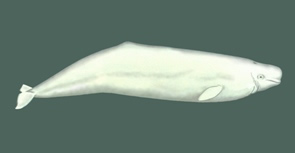Species Index


Key Facts
Length: Up to 5 metresRange: Arctic Ocean
Threats: Pollution, noise disturbance, being cut-off by ice
Diet: Mainly squid, some fish and invertebrates
Beluga Whale
Latin: Delphinapterus leucas
Physical Description
Beluga whales have a number of very distinctive features. The head has a bulbous melon and a short beak with a cleft upper lip; lips can form facial expressions. The body is rotund and thickened by a layer of blubber around the torso, creating folds and creases of fat in places. Adults can measure up to five metres in length. Tail flukes have a distinct notch in the middle and become ornately shaped with age. The dorsal fin is replaced by a small dorsal ridge and the pectoral fins are paddle-shaped. At birth, beluga whales are evenly grey in colour and skin tone lightens with age. Adults become completely white but frequently display a yellowish colouration before their annual moult. Beluga whales can become heavily scarred from scratching against pack ice and from encounters with predators such as polar bears.
Habitat and Distribution
Distribution is circumpolar around the Arctic and is largely determined by pack ice movements. Some whales will winter in polynias (areas of water cut off by ice) and move continually to keep breathing holes open. Sightings of beluga whales in the Hebrides are very rare and are of animals outside their normal range.
Behaviour
Beluga whales live in close-knit social groups and are very rarely seen alone. They are extremely vocal animals with a wide repertoire of vocalisations, and they have a sophisticated sonar system. The beluga whale is a slow-swimming animal that is not known for breaching, leaping or bow-riding. They have been recorded spy-hopping, where they lift their head vertically out of the water to visually survey above the surface.
Food and Foraging
Squid is the main prey of beluga whales but they will also take a variety of fish species, octopus, large zooplankton, crustaceans and bottom-dwelling creatures such as marine worms. Beluga whales have several hunting techniques including driving deep sea fish up into the shallows, cooperatively herding fish together and charging through a shoal of fish and grabbing prey. Their supple lips provide suction when foraging along the seabed. Natural predators of beluga whales are killer whales and polar bears.
Status and Conservation
Current population estimates suggest that there are over 100,000 beluga whales worldwide. The overall population can be divided into five regional populations, some of which are more threatened than others. Being slow-moving and congregating in large numbers made the beluga whale a target for whalers and the species is still hunted in some areas. The main natural threat is from polar bears that wait at breathing holes in the ice and claw at the whales as they surface, sometimes dragging them onto the ice. Occasionally whales become caught beneath the ice without a breathing hole. The St Lawrence River population (estimated at about 650 animals) have high levels of chemical contamination in their bodies and subsequently high cancer rates. Human disturbance from boating, noise made by sonar and development such as hydroelectric plants are of great concern, particularly in calving sites. Beluga whales are protected under UK and EU law, principally under Schedule 5 of the Wildlife and Countryside Act 1981, the Nature Conservation (Scotland) Act 2004 and by the 1992 EU Habitats and Species Directive.





